Maryland Neighborhood Guides
About Virginia, Maryland, & Washington, D.C.
About
Orders to the D.C. area are often accompanied by excitement, followed by a wave of apprehension. D.C. is a massively complex metropolitan area and can be intimidating when deciding where to live. Getting over the sticker shock, understanding the unique challenges of commuting around D.C., and managing expectations are vital to finding the right place to live. But once you tackle all that, you can enjoy everything that comes with living near the nation’s capital!
While choosing where to live can be daunting, the great news is that once settled; most people love their bubbles! School choices, especially in Northern Virginia, are abundant, and career opportunities abound as D.C. is host to professionals in various fields.
Options abound, from full-time jobs to teleworking, but these opportunities come with additional considerations for finding a home. The D.C. area often referred to as the “DMV” (for D.C., Maryland, and Virginia), is one of the best assignments in the military for working spouses. DMV traffic is among the nation’s worst, so finding a home with easy commutes to two different jobs is no easy task.
On the upside, almost everything from parks to libraries, not to mention the museums, is well-funded and free to enjoy. Diversity and rich cultural experiences are plentiful, and the culinary scene is fantastic. Though the cost of living in this region is substantial, you can often find free activities and military discounts.
Professional sports teams include the Washington Redskins (NFL), Washington Nationals (MLB), Washington Capitals (NHL), and D.C. United (MLS), and the Washington Wizards (NBA). People in the area tend to be busy and active, and a competitive spirit permeates all the way down to youth sports.
The weather is almost as intense as the people, with all four seasons in full bloom: hot, humid summers; mild, colorful falls; cold, harsh winters; and breathtakingly beautiful springs.
The first step in choosing where to live is to determine your priorities. There are three main values, if you will, to consider: Home Size, Home Price, and Commute. You will be able to secure one, and potentially even two, of those values—but rarely all three. On each page, we’ll break down some of the more popular areas for military families and explain which values you’ll sacrifice to live there.
Pro Tip: If you come armed with this info before chatting with a real estate agent, they’ll have an enormous leg up in helping you find a home quickly. Efficiency and knowledge are crucial in this hyper-competitive real estate market.
Size
As with many urban cities and surrounding suburbs, the closer you are to D.C., the smaller and more expensive the home, if having a large house is a priority, you’ll live farther out and have a longer commute.
Price
Your money goes further as you radiate away from the District. The “price” you’ll pay for affordability is spending lots of “quality time” in your car. If you LOVE your car or need the time to decompress, go for it! There are also many alternatives to sitting alone in your vehicle for precious waking hours, like slugging, Metro, and VRE or MARC long-haul trains. Don’t worry; we’ll break it all down for you.
Conversely, to reap the benefits of a short commute and proximity to the District, you’ll likely need to be dual-income and willing to spend a significant percentage of your income on housing or be okay with a less-than-amazing home.
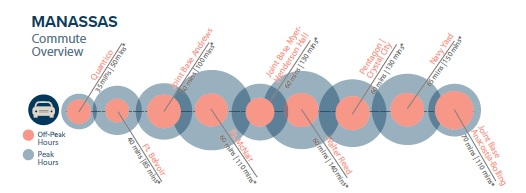
Commute
This is the big one. We cannot stress enough the importance of understanding the traffic situation! Listen up because this can make or break your experience in the D.C. area.
Legendary congestion on all of the main highways, an almost incredible number of people commuting into D.C., and the irregularities of road work, accidents, and weather, make commuting a primary challenge of life in the DMV. We’ve heard stories of two- to three-hour commutes one way, workers giving up and teleworking after moving 15 miles in two hours, and even people stopping off at a winery in the evening and trying again around 8:00 PM (our personal favorite).
You cannot look at distance on a map and equate that to commute time. It could take 30-plus minutes to drive eight miles in the city, and it’s a total gamble on the highways. Flex your creative commuter muscle, and you can discover some workarounds to these headaches. Living close enough to bike or walk to your installation or in proximity to a Metro station will alleviate some stress, and reverse commuting can be a sanity-saver. Also, don’t let anyone tell you that any area is 20 minutes from all the bases. Just walk away from them. It’s so much more complicated than that. But don’t worry—we’ll give you the legit scoop.
Remember, many people stationed at a D.C., Maryland, or Virginia base will work in multiple locations over the length of their time here. For example, those initially stationed at the Pentagon could report to Crystal City (Arlington) and then the following year is sent to Fort Belvoir (southern Alexandria) or Fort McNair (D.C.). You’ll want to know your spouse’s professional trajectory and consider that when choosing a home. Strike a balance for all possible assignments, or at least be okay
with the potential sacrifices.
Commuter Options
Metro – (Washington Metropolitan Area Transit Authority) Metro Rail serves D.C. and the surrounding areas with over 90 stations and more than 100 miles of track. The Metrobus supplements the rail system by connecting lines and stations to outlying communities.
Local Buses – Each jurisdiction has a local system that can supplement the Metro system. If you are farther away from the District, you’ll rely on local buses more often.
Commuter Rails – Virginia Railway Express (VRE) and Maryland Area Regional Commuter (MARC) are long-haul rail systems for commuters.
DOD Shuttle – The Department of Defense operates a fairly robust shuttle system in the National Capital Region. This is an additional commuting option for many.
Bike/Run – There is an extensive multi-use trail system around the D.C. area and the surrounding bases. Many service members enjoy a scenic ride or run to work without stress.
Driving – If you are driving, familiarize yourself with HOV and Express Lane rules.
Ridesharing – There are all sorts of adaptations to carpooling. If you have three or more people in the car, you can take advantage of the HOV lanes (which can save you hours). Sometimes it’s tough to coordinate two other riders and destinations. Therefore, slugging was born. You can go to a designated slug lot and either line up to pick up passengers or hop in a car going in your direction—for free! There are websites and apps to help with coordination. Uberpool and Vanpooling are also variations of ridesharing.
Air Travel – Work trips, flights to see family, or vacations are accessible with three large airports: Washington Reagan National (DCA), Dulles International (IAD), and Baltimore Washington International
(BWI).
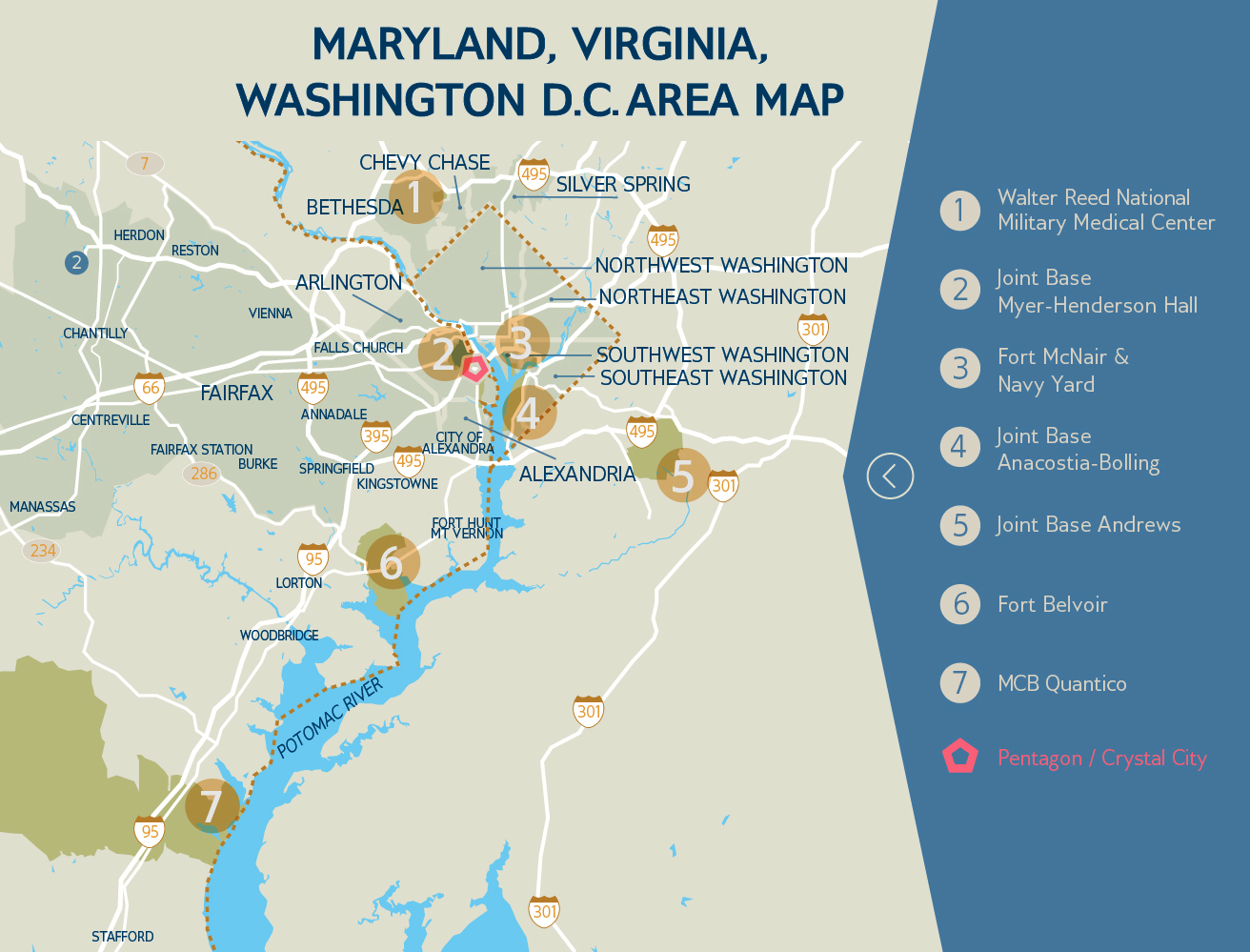
Looking at relocating?
Enter your information below and we will reach out to help the process.
Nearby Neighborhoods
Nearby Neighborhoods
Montgomery County
About
Montgomery County borders the far reaches of upper Northwest D.C. and follows the I-270 corridor between the Potomac and Patuxent Rivers. It’s Maryland’s most populated and affluent county. Communities within the county will range from very urban-feeling areas close to D.C. to suburbs as you move away from the city.
Neighbors
Many government workers trek into D.C., successful attorneys, doctors, and business professionals. Areas closest to D.C. will come with a steep price tag due to proximity. You may bump into some high-ranking military officers in those areas, but we would wager that even they are a dual-income family.
Schools
- Montgomery County Public Schools is one of the largest school systems in the entire United States. The district is divided into clusters, which are geographically defined attendance areas and include elementary and middle schools that feed into particular high schools.
- Students are assigned to a school based on their home address; if you reside outside the Montgomery County Public School system and choose to attend a school in this district, you will incur tuition costs.
- Every eighth-grade student enters a lottery to enroll in their school of choice. Each high school offers distinctive academy programs designed to capture students' interests.
Points of Interest
- The Avalon Theatre
- The Avenue – A small cluster of local shops and restaurants along Connecticut Avenue
- Woodend Sanctuary
- Capital Crescent Trail, linking to Georgetown and Silver Spring
- Cabin John Regional Park
- Bethesda Row and Woodmont Triangle Shopping
- AFI Silver Theatre and Cultural Center
- The Fillmore
- Wheaton Regional Park
- Brookside Gardens
- Downtown Silver Spring Market
Bethesda
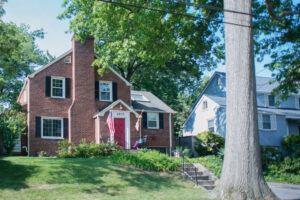 Bethesda was, until recently, considered a bedroom community. But over the last decade, Bethesda has exploded and become a destination with renowned shopping and dining, a vibrant downtown, and affluent neighborhoods replete with grand homes and country clubs.
Bethesda was, until recently, considered a bedroom community. But over the last decade, Bethesda has exploded and become a destination with renowned shopping and dining, a vibrant downtown, and affluent neighborhoods replete with grand homes and country clubs.
Big Plus
- Commuting to Walter Reed is ideal, but getting too many other D.C. area installations is feasible, especially if you plan to use public transit.
- There are many employment opportunities for spouses in Bethesda—and you'll probably need that second income to afford living here.
- The last decade has seen a boom in new development, bringing in retail and restaurants to suit every style and desire.
- Schools fall within the Bethesda-Chevy Chase Cluster. Bethesda-Chevy Chase High School's International Baccalaureate program offers a more global approach to education and emphasizes an internationally recognized program of study.
Things to Consider
- Parking can be scarce, but several public garages and surface lots exist.
- Traffic, as always, is a consideration if you plan to drive yourself to and from work.
- Bethesda is pricey, and you'll have to dig to find something even remotely close to an average BAH rate or be prepared to sacrifice drastically on space.
Commute
For those assigned to Walter Reed National Military Medical Center, you can't beat this commute. The public transportation system is well-connected and robust on the Metro Red line.
Chevy Chase
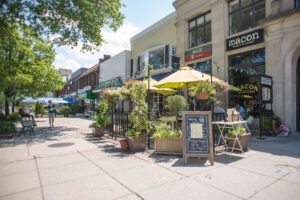 Chevy Chase, Bethesda’s neighbor to the east, embodies small-town Americana with picturesque homes and tree-lined streets. This high-end suburb is replete with green lawns and sleepy streets and provides a refuge from bustling city life. It is a welcoming, family-friendly locale with a quaint downtown that supplies devoted locals with everyday necessities.
Chevy Chase, Bethesda’s neighbor to the east, embodies small-town Americana with picturesque homes and tree-lined streets. This high-end suburb is replete with green lawns and sleepy streets and provides a refuge from bustling city life. It is a welcoming, family-friendly locale with a quaint downtown that supplies devoted locals with everyday necessities.
Big Plus
- This suburb is far enough away from the hustle and bustle of D.C. to provide a quiet refuge for its residents, yet close enough to experience all that downtown D.C. has to offer.
- Chevy Chase boasts tree-lined streets with shaded sidewalks, manicured lawns with well-maintained bungalows, colonials, and Tudor-style homes. However, there are a few condos available near the commercial district.
- Schools fall within the Bethesda-Chevy Chase Cluster. Bethesda-Chevy Chase High School's International Baccalaureate program offers a more global approach to education and emphasizes an internationally recognized program of study.
Things to Consider
- Though quaint, the small 1950s-era main street may leave some yearning for more options. Like in Maryland and D.C., the surrounding neighborhoods can fill the “big box” void.
- Be on the lookout for wildlife and the occasional deer that can wander into your backyard from neighboring Rock Creek Park!
Commute
When residing in Chevy Chase, you will most likely need a car or two. The nearest Metro station is in Bethesda (Red Line).
Silver Spring
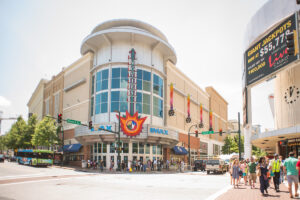 Silver Spring was named for a spring that seemed to sparkle from specks of mica that gave the water a glittery luminescence. The spring is dry, but the city is a thriving D.C. suburb with urban amenities. Dynamic shopping options, eclectic restaurants, and a community-focused arts and entertainment district have helped make Silver Spring a location worth considering.
Silver Spring was named for a spring that seemed to sparkle from specks of mica that gave the water a glittery luminescence. The spring is dry, but the city is a thriving D.C. suburb with urban amenities. Dynamic shopping options, eclectic restaurants, and a community-focused arts and entertainment district have helped make Silver Spring a location worth considering.
Big Plus
- Downtown Silver Spring is a destination in and of itself. The area is brimming with great shopping, restaurants serving a variety of global cuisines, outdoor festivals, and community events. New retailers are consistently moving in, and employers like NOAA, Discovery Communications, and the American Film Institute have put down roots in Silver Spring.
- Montgomery County Public Schools are considered by many to be some of the best in the country. One of Silver Spring’s high schools, Montgomery Blair High School, is known for its two magnet programs - Math, Science, Computer Science, and a Communication Arts Program.
- Silver Spring is family-friendly with parks, museums, entertainment, and events for kids of all ages.
Things to Consider
- While plenty of shops and restaurants are available to fulfill your daily needs, chains and big-box stores aren’t as open here. Nearby, Bethesda and neighboring D.C. can fill in any gaps.
- Street parking can be a challenge, but several large parking garages are downtown. The area is very pedestrian friendly, so do like the locals do and just walk!
- Schools in Silver Spring are a part of the Downtown Consortium, which contains over 80 schools.
Commute
You could potentially “go one car” here with the abundance of public transit options, which is unique for a relatively quiet suburb. The Metrorail’s Red Line services the area with a transportation hub in Silver Spring that also has stops for the MARC train and multiple local and Metro bus routes. Walter Reed is the ideal commute from this suburb, but getting on the Metro to the other D.C.-area installations can be an option. If you drive to and from work, the traffic is considerable during rush hour. This segment of the Beltway sees some of the region’s heaviest traffic.
Howard County
About
Howard County is sandwiched between the DC and Baltimore metropolitan areas. This area can open up possibilities for career-minded spouses in both major cities.
Neighbors
Columbia, the largest city in Howard County, was designed to be a paragon of diversity and strives to have housing suitable for various budgets. Townhomes, single-family homes, condominiums, and apartments are all found here. As you move west along the Interstate 70 corridor, the communities become more spread out, and many are downright expensive.
Commute
There is quick access from Columbia to MD-32 (Patuxent Freeway), US Hwy 29, and Interstate 95. Your time will increase as you move west. Though there’s no metro access here, there are MARC stations in Savage, Jessup, and Dorsey. North Laurel and Columbia areas are well connected with commuter buses. Baltimore/Washington International Thurgood Marshall Airport (BWI) is easily accessible.
Schools
- Howard County School District boasts 42 elementary schools, and 20 middle and twelve high schools. With this many options, it is essential to research the schools carefully and verify your zoning directly with the district.
- More than 57,000 students are enrolled in 77 schools in the Howard County Public School System. Four elementary schools, six middle schools, and one high school were named Blue Ribbon Schools.
- Private schools in Columbia include Columbia Academy, Atholton Adventist Academy, Celebration Christian Academy, Love of Learning Montessori School, and The Julia Brown Schools (Montessori).
Points of Interest
- Lake Kittamaqundi
- Robinson Nature Center
- Lake Elkhorn Park
- Historic Oakland Mansion
- Patuxent Branch Trail
- Mall of Columbia
Columbia
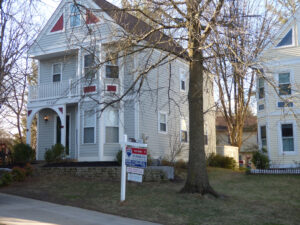 Columbia is one of the most popular locales in the area. A master-planned community founded in the 1960s, Columbia is comprised of ten “villages,” each with several neighborhoods offering a variety of home styles, recreation activities, schools, and shopping options.
Columbia is one of the most popular locales in the area. A master-planned community founded in the 1960s, Columbia is comprised of ten “villages,” each with several neighborhoods offering a variety of home styles, recreation activities, schools, and shopping options.
Big Plus
- The Columbia Association provides a nearly endless list of amenities—golf courses, an equestrian center, fitness clubs, outdoor concerts, a nature center, a farmers’ market, a dog park, and an ice rink, to name a few!
- The quality of life in Columbia is excellent, with a fantastic variety of housing options, school options, and community amenities.
Things to Consider
- Between the Columbia Association fee and HOA fees, costs can add up.
- Columbia lacks a MARC station, making commutes to Washington, D.C., car-dependent.
Commute
Anything along the Interstate 95 corridor between the D.C. metro area and Baltimore is bound to be busy. Commute buses and carpool options are scattered across the city, but you’ll need to drive a bit to get to a MARC station. This location is ideal for anyone heading to Fort Meade, but anything south of D.C. will be quite a haul.
Laurel
Located north of D.C. and west of Fort Meade, Laurel straddles three counties - Anne Arundel, Howard, and Prince George’s County. Laurel has a small historic district where you can see remnants of its past as a mill town and is known for affordability and convenience.
Big Plus
- Two MARC stations allow for commutes from Laurel to D.C.
- Laurel is more affordable than some nearby areas.
- The annual Main Street Festival is a celebration of Laurel that draws thousands of people and features a parade, food vendors, and bands.
Things to Consider
- There are plenty of safe, nice areas, but some places haven’t been maintained. Be sure to research the surrounding areas of any property you are considering.
- Since parts of Laurel fall under three counties, property taxes and school options will vary depending on where you live in Laurel.
- With three school districts and hundreds of school options, there’s a lot to consider. Spend time browsing the school district sites to familiarize yourself with your options.
Commute
The commute to Fort Meade is short, about 15 to 20 minutes in ideal traffic conditions, and can be as long as 30 minutes during peak travel times. Laurel is close to MD-200 (Intercounty Connector), MD-295 (Baltimore-Washington Parkway), US Highway 1, and Interstate 95. Laurel also has two MARC stations, which are good options for Washington, D.C. commuters.
ANNE ARUNDEL COUNTY
About
Anne Arundel County is located on the western shore of the Chesapeake and is home to Annapolis, Maryland’s state capital. This area is deeply influenced by its proximity to the greater D.C. metro area and the maritime history of Annapolis. You’ll see those influences more profound depending on which side of the site you live in.
Neighbors
The western side of Anne Arundel county will be more deeply connected to the greater D.C. area, with professionals commuting into D.C. or other locations around the region. Some may even commute to Baltimore.
Commute
Commuters will primarily rely on driving from this region as it lies just outside the reach of the WMATA transportation network. MARC offers the Penn line train, which stops in Odenton, along with some commuter bus routes that might be an option. Those assigned to Fort Meade, Joint Base Andrews, Joint Base Anacostia-Bolling, and the United States Naval Academy will find this a convenient location.
Schools
- Anne Arundel County Public Schools (AACPS) is a large district with 128 schools enrolling approximately 83,000 students. Eighteen schools in the community were recipients of the National Blue Ribbon, an award recognizing overall academic excellence or a school’s progress in closing achievement gaps. Additionally, 21 AACPS schools won the Maryland Blue Ribbon.
- Schools in the AACPS district are well-versed in addressing the needs of military children, with around 8,000 military-connected children in the district.
- With so many schools in this district, it’s essential to research your school options carefully and verify zoning directly with the district.
Points of Interest
- Walden Country Club
- Globecom Wildlife Management Area
- Crofton Park
- Bell Branch Athletic Complex
- Chartwell Golf & Country Club
- Kinder Farm Park
- Severn River Sanctuary
- Magothy River
- B&A Trail
- Olde Severna Park – Historic Downtown
- Eisenhower Golf Course
- Anne Arundel County Fairgrounds
- Maryland Renaissance Festival
- Bacon Ridge Natural Area
Annapolis
Quaint and charming are common descriptors for Annapolis, a coastal town best known for being the state capital of Maryland and home to the United States Naval Academy. The historic downtown area is the heart of Annapolis. There is a lot to do in this highly walkable area, from exploring the City Dock to enjoying a cold treat at one of the city's many ice cream parlors.
Big Plus
- You will not lack things to do in this vibrant city, with its robust cultural scene, great restaurants, and nearly every water-based activity you can imagine.
- The area—especially the quaint downtown—is beautiful and desirable, with lots of character and charm.
- Naval Academy Primary School is a private elementary school open to children of active-duty and retired military personnel and USNA employees. The school's primary mission is to serve the children from the Annapolis-area military community, and the school is particularly adept at addressing their needs. The school is conveniently located close to both the USNA and NSA-Annapolis.
Things to Consider
- Prepare yourself for the sticker shock—this area can be very pricey, especially near the water.
- Annapolis loses some of its charms and has a typical suburban vibe outside the historic area.
- Traffic congestion is a reality in this famous town, especially when there is an event at the Naval Academy and during peak tourist season.
- Annapolis has an income disparity, with some low-income areas peppered among exclusive neighborhoods. There are limited property options for the middle class.
Commute
Traffic can be a consideration, particularly during the peak tourist season in the summer and when the Naval Academy hosts significant events. The commute from Annapolis to the Naval Academy is speedy, just minutes in most parts of town. Fort Meade is about an hour in peak traffic, but other D.C. area installations will likely be too far.
Arnold
Across the Severn River from Annapolis, Arnold is a waterfront town on the Broadneck Peninsula that stretches to the shores of the Magothy River to the north. There is a small-town feel to this somewhat secluded area. Arnold enjoys the same natural beauty as Annapolis but without the hustle and bustle of the larger city.
Big Plus
- Arnold has more options for middle-class buyers than nearby Annapolis.
- The pace of life in Arnold is more relaxed. Families appreciate the laid-back vibe.
- Schools are top-notch in Arnold.
Things to Consider
- Though you can find reasonably priced properties in Arnold, prices creep up as you get closer to the waterfront and can quickly exceed the budget of most military families. Be realistic about what your budget will allow.
Commute
The commute to the United States Naval Academy is ideal, about ten minutes without any major traffic concerns. Fort Meade is about 30 minutes but will increase during peak traffic times.
Crofton
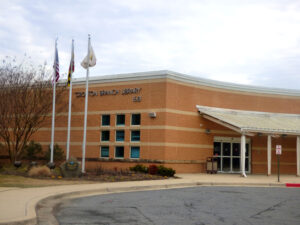 Crofton is a sought-after community south of Fort Meade and west of Annapolis and the United States Naval Academy. The town is encircled by a four-mile parkway, with all the Crofton elementary schools located within this family-oriented development.
Crofton is a sought-after community south of Fort Meade and west of Annapolis and the United States Naval Academy. The town is encircled by a four-mile parkway, with all the Crofton elementary schools located within this family-oriented development.
Big Plus
- Housing options consist of townhomes, apartments, and single-family homes. Mature trees are plentiful, adding to the park-like feel of the area.
- Crofton public schools enjoy excellent ratings and are quite desirable.
- As a master-planned community, numerous amenities are available to residents, including pools, trails, and athletic fields.
Things to Consider
- Traffic can be significant in the area and can lengthen the commute to Fort Meade.
Commute
Crofton is close to major thoroughfares. The commute to Annapolis is about 20 minutes in ideal traffic conditions. Driving to Fort Meade will take at least 30 minutes.
Crownsville
Follow the Severn River northwest from Annapolis, and you will reach Crownsville. This small town is close to Annapolis but offers quiet living, excellent schools, and beautiful vistas.
Big Plus
- Many communities in Crownsville have water access available to residents, a boon if you enjoy the water!
- Many established neighborhoods along the Severn River were built as vacation homes and are now used as year-round residences. There are reasonably priced properties to be found in these designated areas.
Things to Consider
- Crownsville is nearly all residential. Shopping is available about ten minutes away in Millersville.
- There are no public beaches or marinas in town; access is limited to those living in the beachfront communities.
Commute
Crownsville is approximately 15 to 20 minutes from downtown Annapolis and 20-30 minutes from Fort Meade. It generally does not experience heavy traffic patterns. Joint Base Anacostia-Bolling and Joint Base Andrews are about an hour away, but other installations in the D.C. metro area will be far from here.
GAMBRILLS
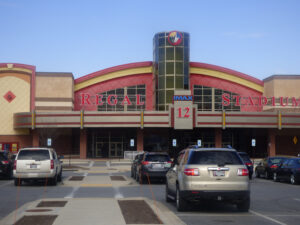 Gambrills is a small town nestled between Odenton and Crofton. This friendly community is increasing and is close to the MARC commuter station in Odenton. Though its small size may fool you, Gambrills is a favorite shopping destination with many upscale tenants.
Gambrills is a small town nestled between Odenton and Crofton. This friendly community is increasing and is close to the MARC commuter station in Odenton. Though its small size may fool you, Gambrills is a favorite shopping destination with many upscale tenants.
Big Plus
- Larger homes are available in this upscale community.
- It offers a welcome change of pace from some of the more densely populated areas nearby.
- There’s a Wegmans—the best grocery store ever!
Things to Consider
- Gambrills is missing some of the amenities of the larger master-planned communities nearby, such as equestrian centers and skating rinks.
Commute
Gambrills has quick access to the major roads in the area. Fort Meade is a short drive to the northwest.
Millersville
 Millersville is a small area known for being a bit more affordable than nearby Severna Park. The homes are mainly from the ‘60s, ‘70s, and ‘80s. Families are attracted to the more reasonable home prices and stellar schools.
Millersville is a small area known for being a bit more affordable than nearby Severna Park. The homes are mainly from the ‘60s, ‘70s, and ‘80s. Families are attracted to the more reasonable home prices and stellar schools.
Big Plus
- Your housing dollars will go further in Millersville.
- Schools are excellent in this small community and include some private school options, such as Elvaton Christian Academy and Rockbridge Academy.
Things to Consider
- Millersville is quiet and does not have as many suburban perks as some of the neighboring areas.
Commute
There is quick access to MD-3 (Crain Highway), MD-32 (Patuxent Freeway), MD-175, MD-178, and Interstate 97.
Odenton
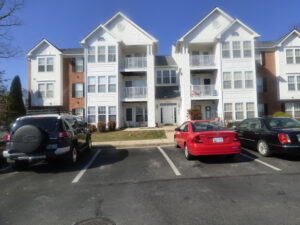 Located just south of Fort Meade, Odenton is a growing town that boasts excellent schools, varied housing options, and easy access to public transportation. Families are particularly fond of this area; you will see many children running around Odenton’s subdivisions.
Located just south of Fort Meade, Odenton is a growing town that boasts excellent schools, varied housing options, and easy access to public transportation. Families are particularly fond of this area; you will see many children running around Odenton’s subdivisions.
Big Plus
- Odenton is close to Fort Meade, making for easy commutes.
- Schools in Odenton are well regarded.
- With a MARC station in town, those commuting to D.C. can take public transportation.
Things to Consider
- Traffic can be heavy, particularly around rush hour.
- Townhomes are common. Though most properties were built in the last century, some new construction is available.
Commute
Odenton has the advantage of offering public transportation options for travel into Washington, D.C. There is a MARC (Maryland Rail Commuter service) station in town, which is a boon to commuters and those who wish to explore the nation’s capital. There is quick access from Odenton to most of the major thoroughfares. The commute to Fort Meade is short, and the Baltimore/Washington International Thurgood Marshall Airport is easily accessible.
SEVERNA PARK
 Severna Park is the most upscale of the communities surrounding Fort Meade. Bordered by the Severn River to the southwest and the Magothy River to the northeast, Severna Park has many waterfront properties available, and all residents enjoy the beauty of the waterways.
Severna Park is the most upscale of the communities surrounding Fort Meade. Bordered by the Severn River to the southwest and the Magothy River to the northeast, Severna Park has many waterfront properties available, and all residents enjoy the beauty of the waterways.
Big Plus
- Severna Park has more detached properties available than the surrounding communities if you’re hoping to settle in a single-family house instead of a townhome.
- With two rivers in the town, Severna Park has beautiful views.
- Severna Park is close to Annapolis, the beautiful state capital and home to the United States Naval Academy.
- Schools in Severna Park are top-notch at every level.
Things to Consider
- Severna Park is pricey. Expect to pay a premium for living in this “tony” (posh) area.
- Traffic is a fact of life and can extend commute times.
- Severna Park lacks public transportation options for travel into Washington, D.C. There is no MARC station.
Commute
There is quick access from Severna Park to major highways. The commute to Fort Meade is a half hour in ideal traffic conditions and can take up to 45 minutes during peak travel times. The Commute to the United States Naval Academy is typically between 20 and 40 minutes, depending on the location.
Prince George's County
About
Located right along the eastern border of Washington, D.C., Prince George’s county is a bustling extension of the D.C. metropolitan area. Next to Montgomery County, it’s the second most populous county in Maryland. It’s also home to Joint Base Andrews, Anacostia-Bolling, and many other federal government facilities.
Neighbors
This county attracts working- and middle-class families to the area and embraces the diversity that the National Capital Region prides itself on. Due to its proximity to the Beltway, many are employed in government and non-profit sectors, particularly education, health care, and social services. Areas closest to the city are urban and densely populated, with areas to the south retaining a very rural feel.
Commute
Interstate 485 is a significant connector through this area. Areas inside the Beltway offer a few Metro Stations, but the MARC transit stations are limited to the northern portions of the county.
Schools
- Prince George’s County Public Schools includes more than 200 schools and more than 136,000 students. There are also numerous private school options in the northern part of the county.
- Prince George’s County Public Schools offer unique learning opportunities, including career-readiness programs, dual enrollment, and language immersion.
- With more than 200 schools in the district, it is essential to research the schools carefully and verify your zoning directly with the district before committing to a home. Transfers from the district are not shared in Maryland, so your school choice is essential.
Points of Interest
- Montpelier Mansion
- National Wildlife Visitor Center
- Laurel Park
- Patuxent Research Refuge – North Tract
- Laurel Museum
- Laurel MARC Station
- The Gardens Ice House
- Dinosaur Park
- Six Flags America
- Bowie Railroad Museum
- National Capital Radio and Television Museum
- Belair Mansion
- Belair Stable Museum
- NASA Goddard Visitor Center
- Allen Pond Park
Bowie
Nestled between the Washington, D.C., and Baltimore, MD, commuting areas, Bowie is a suburban haven home to more than 55,000 residents. Despite its proximity to two major metropolitan areas, Bowie is proud to claim more than 1,100 acres of parks and preserved open spaces, including more than 22 miles of paths and trails and 75 ball fields.
Big Plus
- A MARC station located at Bowie State University, along with a nearby park-and-ride option for commuter buses and vanpools, offer convenient options for commuters.
- Located between D.C. and Baltimore, you can enjoy all those cities with an easy drive or train ride in the middle of three major cities: D.C.
- Career-minded spouses have plenty of employment opportunities to consider within a short commute.
Things to Consider
- There are plenty of great neighborhoods, but pockets of areas haven’t been as well-maintained. Be sure to research the surrounding areas of any property you are considering.
- Traffic can be significant in the area and can lengthen the commute to Joint Base Andrews and Fort Meade.
Commute
Bowie is located approximately fifteen minutes outside the Beltway so most commuting options will center around I-495 and I-295. MARC trains are accessible at the Bowie State University station. The commute to Joint Base Andrews or Fort Meade is about 30 minutes in ideal traffic conditions and can be as long as 45 minutes during peak travel times.
Fairwood
Fairwood is a sought-after community in Prince George’s County located northeast of Joint Base Andrews. Fairwood encompasses only 3.5 square miles and has a total of 1,800 homes. Though tiny compared to its big-city neighbors, it offers an impressive array of amenities, including walking paths, ponds, community areas, a community center, pools, parks, recreational complexes, and nature trails.
Big Plus
- As a master-planned community, numerous amenities are available to residents, including pools, trails, and athletic fields.
- Located between D.C. and Baltimore, you can enjoy all those cities with an easy drive or train ride.
- Thrill-seekers will enjoy the fact that Six Flags America is on the south side of Fairwood, a mere ten-minute drive away.
Things to Consider
- Since this is a relatively small area, the inventory can be similarly limited and likely move quickly.
- Most new construction in Fairwood has ended, so you’ll be looking at an array of existing single-family homes and several options for townhomes and condominiums.
- Traffic can be significant in the area and will lengthen the commute to nearby bases.
Commute
Fairwood is located approximately fifteen minutes outside the Beltway via either Annapolis Road or John Hanson Highway. Any MARC stations do not serve Fairwood, so you’d need a car to get to the closest stations in Lanham or Bowie. Fort Meade, Joint Base Andrews, and Anacostia-Bolling are the tightest installations.
Lanham
Lanham is located northeast of Washington, D.C., just outside the Beltway, in Prince George’s County, Maryland, and is well-suited for anyone seeking convenient commute options and easy access to the services, amenities, and attractions that both cities offer. Lanham has a busy Town Center with plenty of shopping and dining options and several great parks and green spaces for recreation.
Big Plus
- Easy access to I-495 and Joint Base Andrews
- Offers homes suitable for various needs and budgets, including single-family homes, townhomes, and condominiums.
- Convenient to major retail centers, and medical services, both within Lanham and in surrounding towns – including a Wegmans for the foodies!
Things to Consider
- As with any area on the edge of a central metropolitan area and along a major highway, some areas aren’t as well-maintained or may have substantial traffic noise. A trusted real estate agent will help you identify areas that are a good fit for you.
- The area is entirely developed, so new construction is hard to find. Still, there are plenty of options for homes built within the last ten years, older homes that have been thoughtfully renovated, or fixer-uppers for those seeking value.
Commute
Lanham is located just outside the Beltway, which makes it well-connected to most major thoroughfares. Fort Meade, Joint Base Andrews, and Anacostia-Bolling are the closest installations. Lanham is conveniently located at the Seabrook MARC station, New Carrollton MARC, and Metro Stations.
WESTPHALIA
Westphalia is a master-planned community in central Prince George’s County, tucked between Largo, Upper Marlboro, and Joint Base Andrews. Westphalia is worth considering for its diversity, convenient location, and impressive amenities, including walking paths, ponds, community areas, and parks. Future development plans include proposals for another elementary school, a library, and mixed-use development.
Big Plus
- Master-planned communities offer great amenities to their residents
- Easy access to I-495 and Joint Base Andrews
- Continued growth and development in the community may mean more housing options available.
Things to Consider
- Since Westphalia is still growing, some amenities aren’t available yet, and areas are under development.
- While it does have some retail and dining options, large retail centers with big box stores and medical services are located in surrounding towns such as District Heights, Largo, Upper Marlboro, and Clinton.
Commute
Westphalia is located on the edge of the Beltway, so it is well-connected in either direction. Joint Base Andrews and Joint Base Anacostia-Bolling are the closest installations. MARC Park and Ride lots are located in Upper Marlboro for those commuting into D.C.
Looking at relocating?
Enter your information below and we will reach out to help the process.
7 Reasons You Should Consider Buying a Home
1. TAX ADVANTAGES
To encourage homeownership, the IRS has provided many tax breaks for owning a home. Credits may be available for specific home improvements, such as using clean energy or for qualified first-time home buyers. The way most homeowners see those advantages is through income tax itemization and deductions like mortgage interest and real estate taxes.
2. STABALIZE MONTHLY HOME COSTS
Owning your own house is one of the safest bets on stabilizing your monthly home costs. There’s no worry of rent getting increased significantly after each year of living in someone else’s home. Additionally, when you answer to yourself, there is no worry of landlord changes or unexpected lease termination.
3. HOUSE HACKING
Generally speaking, house hacking is a smart strategy that involves renting out a portion of your primary residence as a means of generating income to offset your own living expenses. Think turning your finished basement or mother-in-law quarters into an AirBnB! Or consider purchasing a multi-unit duplex or triplex: live on one side and rent out the other! If your home making money while you’re living in it doesn’t sound like your thing, there’s always renting it out after you PCS as an income generating investment property.
4. Increased Privacy
Generally speaking, house hacking is a smart strategy that involves renting out a portion of your primary residence as a means of generating income to offset your own living expenses. Think turning your finished basement or mother-in-law quarters into an AirBnB! Or consider purchasing a multi-unit duplex or triplex: live on one side and rent out the other! If your home making money while you’re living in it doesn’t sound like your thing, there’s always renting it out after you PCS as an income generating investment property.
5. Pets Are Welcome!
For those who choose to rent instead of buying, it can be extremely difficult to find rentals who allow for your
four-legged, furry friends. Landlords often require hefty pet deposits or place heavy restrictions on the number of pets and breeds they allow—if they will even allow pets. When considering quality of life, including beloved pets and the indoor and outdoor space available to them matters. Having the flexibility to include ALL members of your family as a homeowner is priceless!
6. Pride of Ownership
One of the greatest benefits of owning your own home is the pride of ownership that comes along with it. Not only are homeowners more inclined to take good care of their investment with routine maintenance and cleaning, but also they are free to make design choices ranging from hanging artwork on the walls, to paint colors, to customization of closets, electronics, and more. As military families who relocate frequently, having your home reflect who you really are feels important.
7. Safe and Stable Long Term Investment + Forced Savings
Owning a home has historically been one of the safest, lowest risk financial investments that tends to have long-term stability and success. As your home value appreciates and your mortgage balance decreases, what’s left is growing equity with an eventual paid off home. Making a monthly house payment is akin to setting aside a specific amount each month into a savings account—it’s a little difficult to access in the moment, but over time it can build into something significant in the form of equity.

FIVE RESOURCES TO HELP YOU IN YOUR RELOCATION PROCESS

Your PCS is underway!
The home buying and moving transition process has begun. Now what? If it feels like there are a million things to do, don’t fret because you don’t have to do them all yourself. During the relocation process, there are many service providers that can assist you in making your move a smooth one.
Consider these five resources to help you in the process
1. MOVING COMPANIES
Sure, the military offers transportation and relocation services, but many service members decide to coordinate the transfer of household goods themselves. Not only can you often earn money on the difference between moving costs and weight allowances, but you can be assured that you have more control over your belongings. Services that moving companies offer can range from delivery of boxes and pods for the “you-pack” model all the way to full-service logistics companies that will do all of the packing, loading, driving, and unpacking for you.
2. STORAGE
Whether you need to store your household goods for a few weeks until you close on your home or you decide that you have more stuff than square footage, storage companies abound. Sizes, conditions, and contracts vary widely so be sure to do your homework before you commit. Particularly in climates with extreme cold, heat, or humidity, it is important to consider using only climate-controlled storage to ensure the protection of your furniture and temporarily unused items.
3. TEMPORARY HOUSING
It is not uncommon for there to be a short gap of time during a military move between when you arrive at your new duty station and your new home being available to inhabit. No longer are hotels the only option for sticking out a few days or weeks during the wait. Vacation Rentals by Owner (VRBO) and Airbnb are great options to make you feel more at home while you wait for your home. In fact, why not take advantage of seeing your new city through the eyes of a tourist? Find a location near new local attractions and dining and enjoy a few days of getting to know the lay of the land.
4. USPS/IRS
Once you get settled in at your new home, it’s important that you alert agencies that will make sure your current and up-to-date address is on file. The United States Postal Service (USPS) and the Internal Revenue Service (IRS) are two of the most important and by doing so, any important mail or documents in your name should be forwarded or sent along to your new address. It’s also a good idea to notify banks, credit card companies, and other debt collectors of a change of address. These days nearly all of these transactions can be handled online.
5. DISCARD & DONATE SERVICES
No matter how much you purge, toss, organize, minimize, or donate before you pack up the moving truck, it never fails that after you get unpacked on the other side there seems to be more stuff to declutter. Discard and donate services can help with this. Many are a phone call away and will happily come to your residence for a pickup. Others are structured where you simply drop off at a store. A lot of these services are charitable organizations and will offer you documentation for your own taxes based on your donation. It’s a win-win: you downsize by donating, and someone else benefits from your use of your items.

